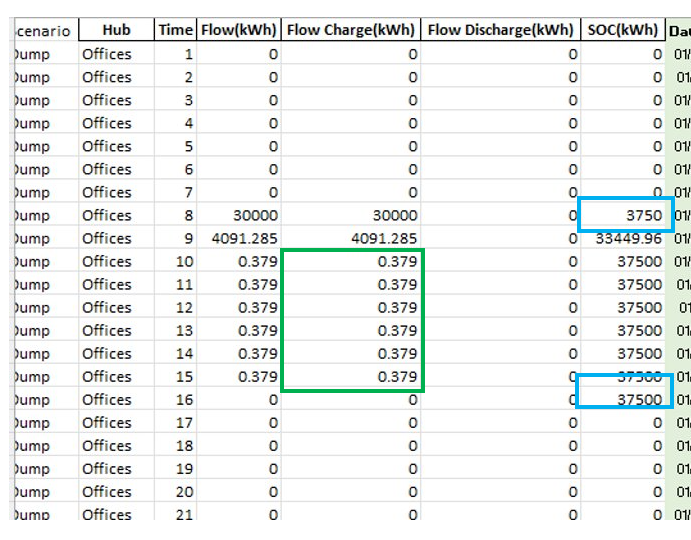Add EV Batteries
1. The three charging strategies of EV batteries
Electrical Vehicle (EV) Batteries can be added in your scenario as storage technologies with fixed size. 3 charging strategies can be modelled.
The target state of charge (SoC) at the end of the charging cycle is the amount of energy that will have to cover the driving distance (as defined by the user) during the day.
Charging strategy | Charging | Discharging (to grid) |
|---|---|---|
Dump (Monodirectional) | Vehicle battery charges at the plug-in hour. The charging power is constant and equal to EV-Plug-in Power (kW) until the vehicle battery is fully charged. | Not allowed |
Smart (Smart - Monodirectional) | Vehicle battery charges at the (optimal) best hour after plug-in. The maximum charging power is EV-Plug-in Power (kW). | Not allowed |
V2G (Smart - Bidirectional) | Vehicle battery charges at the (optimal) best hour after plug-in. The maximum charging power is EV-Plug-in Power (kW). | Vehicle battery can discharge stored electrical energy to the grid during the hours of plug-in. The maximum discharge power is EV-Plug-in Power (kW). |
Monodirectional (Dump)
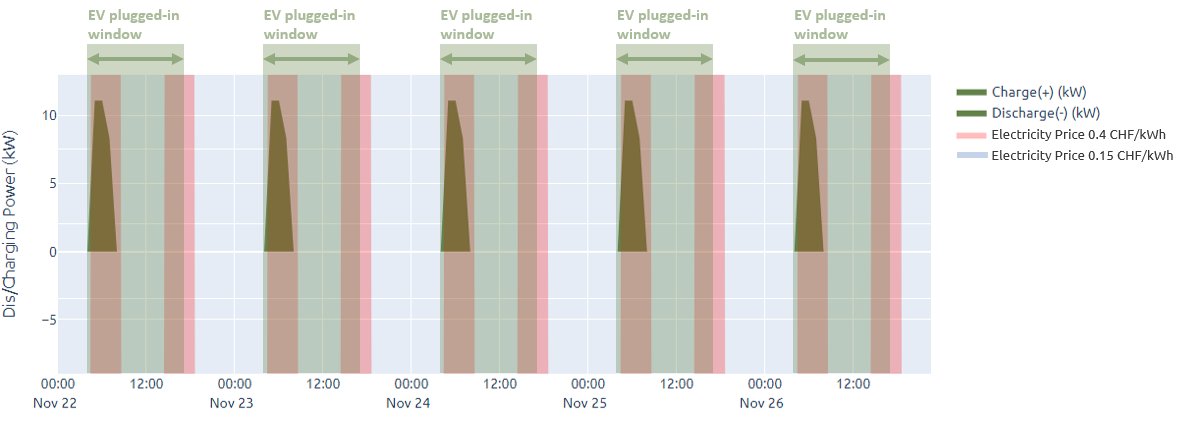
Example of Monodirectional charging power (kW) of an EV Battery during a work week. The charging of the EV battery isn’t controlled and it starts charging as soon as it’s plugged-in
Smart Monodirectional (Smart)
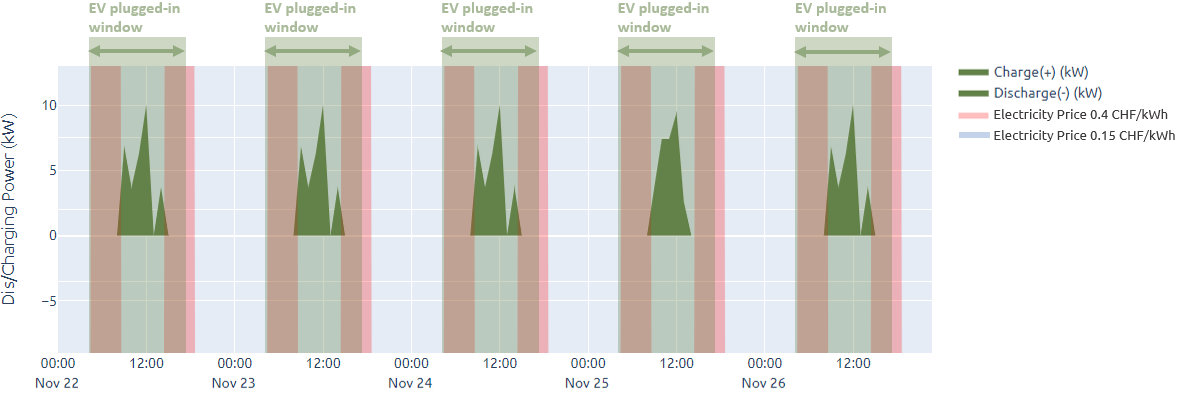
Example of Monodirectional Smart charging power (kW) of an EV Battery during a work week. In the case of the optimal cost solution, the charging of the EV battery fluctuates and starts later when the price of the grid electricity is lower (0.15 CHF/kWh).
Smart Bidirectional (V2G).
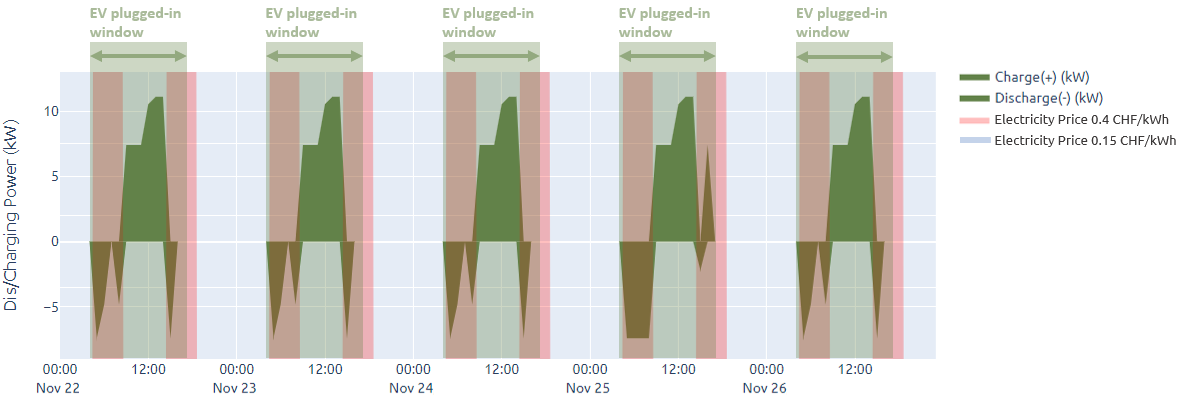
Example of Bidirectional Smart (V2G) dis/charging power (kW) of an EV Battery during a work week. In the case of the optimal cost solution, the vehicle charges when the price of the grid electricity is low (0.15 CHF/kWh) and discharges when the price of grid electricity is high (0.4 CHF/kWh).
2. How to add EVs as storage technologies
On the Supply Technology page, Storage Technology Candidate section, click on Create Custom → toggle on E-mobility Parameters and fill in the necessary entries.
In the “Storage Parameters” section, the user can leave the Technology Capacity and Maximum Capacity as default as this will be overwritten by the EV Battery Size in the “E-Mobility Parameters” section.
The user also does not need to fill the Dis/Charging Parameters section as this will be overwritten by EV Plug-in Power in the “E-Mobility Parameters” section.
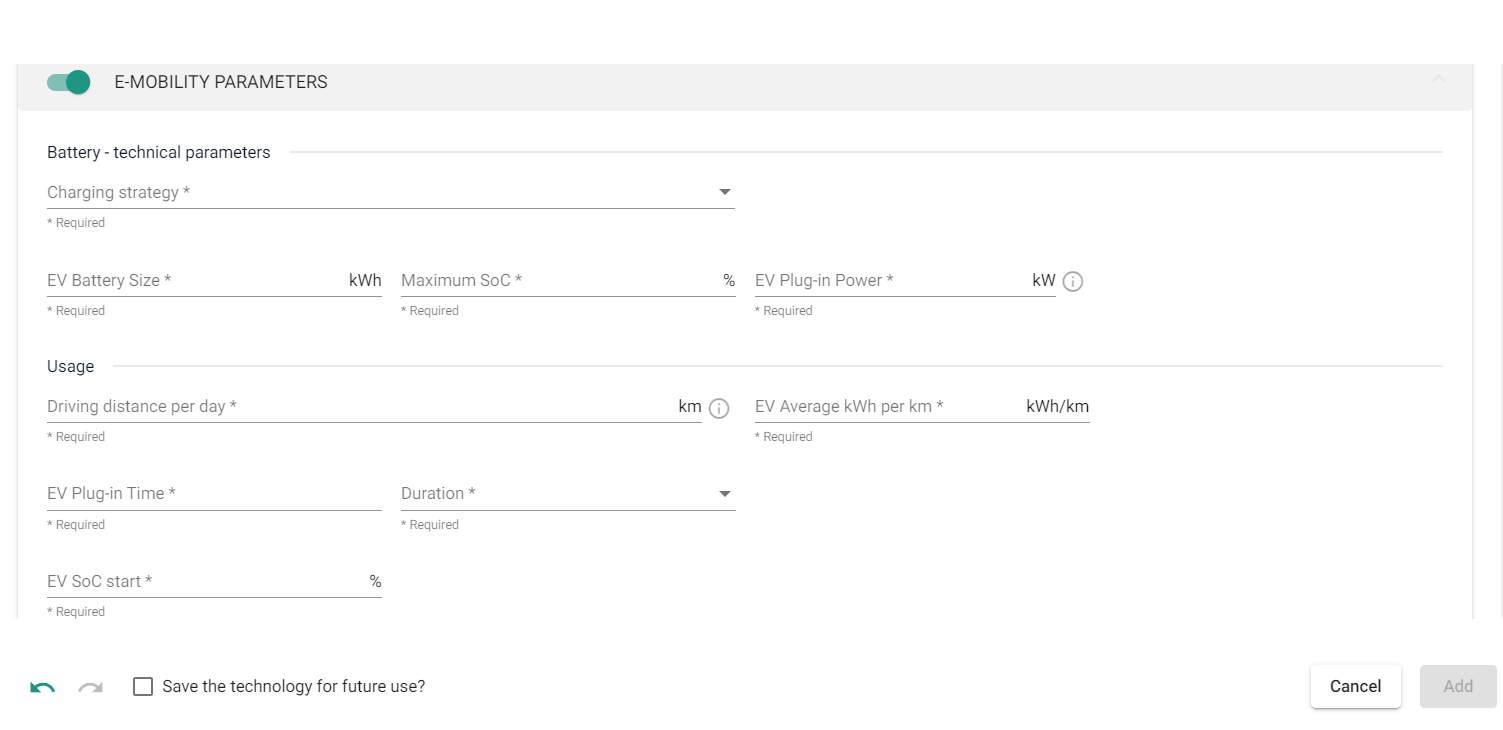
Screenshot of the E-Mobility Parameters
3. Definition of parameters in Sympheny
The rest of the parameters needed for the definition of the EV batteries are explained in the table below:
PARAMETER | UNITS | EXPLANATION |
E-MOBILITY PARAMETERS |
|
|
EV Plug-in Time | hour | The hour of the day when the EV batteries can be plugged-in to the electrical circuit of the system. It can’t be “00:00” |
EV Plug-out Time | hour | The hour of the day when the EV batteries can be plugged-out to the electrical circuit of the system. It can’t be “00:00” |
EV Plug-in Duration | hours | The total hours that the EV battery will be connected. It must be less than 24 hours |
EV Battery Size (kWh) | kWh | The total size of the EV batteries in kWh considered in the system |
EV Plug-in Power (kW) | kW | The maximum possible power in kW to charge the EV batteries. For Dump charging, this is the constant power that the battery charges at until it is charged to the final SoC. |
EV SoC start (%) | % of total capacity | The initial State of Charge (SoC) of the EV batteries when they are plugged-in. |
Maximum SoC (%) | % of total capacity | The maximum State of Charge (SoC) allowed for the EV batteries |
Driving Distance per day (kms) | km | The driving distance (kms) of the EV which must be able to cover after charging the EV battery. Used for calculating the final SoC of the battery at the end of the charging cycle. |
EV Average kWh per km | kWh/km | The average consumption of the EV in kWh per km driven Used for calculating the final SoC of the battery at the end of the charging cycle. |
While running the scenario some warning messages might be sent to alert about the following:
That the charging power during the entire charging cycle won’t be enough to reach the target Driving Distance for the car.
That the EV battery has enough starting SoC to cover the target Driving Distance of the car, so the charging won’t be necessary. (Only for the cases of Monodirectional charging strategy)
In this case, you will simply have to adapt the input parameters according to the alert sent.
4. Can I model EV as a demand instead?
In Sympheny, you can model EV as a demand as well. To do so, you can add a typical electricity demand profile as detailed under section Add Energy Demand. By defining an exogenous profile, you will not capture the dynamic charging and discharging behaviour of smart charging.
As storage technology | As demand | |
|---|---|---|
Total electricity consumption by EV | The daily electricity consumption is the amount of energy required to reach the SoC level at end of the charging cycle, plus stand-by losses. | As described by hourly demand profile |
Charging strategy | Dump, Smart - monodirectional, Smart - V2G | As proxied by the exogenously-defined profile Load shifting can be considered by adding a ‘virtual’ battery (whose sizing has to be decided by the user) |
Optimisation of EV versus gasoline fleet | Not possible, as EV demand has to be defined | Possible, with a vehicle energy demand pattern that can be fulfilled by either electricity or gasoline fuel. |
Typical case for usage |
|
|
Questions answered with model? |
| |
|
| |
5. An example of EV modelled
The outputs below are of a Dump EV with the following parameters:
EV Battery size - 37 500 kWh
EV SoC Start - 10%
Plug-in time - 08:00
EV plug-in duration - 8 hours
EV plug-in power - 30 kW
distance travelled per day - 26'250 km
EV average kWh per km - 0.24 kWh/km
From the results below,
The SoC at 8 am (plug-in time) is 3'750 kWh (10% of the batterie size, 37'500 kWh).
The target SoC is 37 500 kWh
The EV charges at max plug-in power at 30 kW in the first hour, and 4.09 kW in the subsequent hour to reach the target SoC.
There is continuous charging during the plug-in cycle to recharge the power loss from to stand-by.
